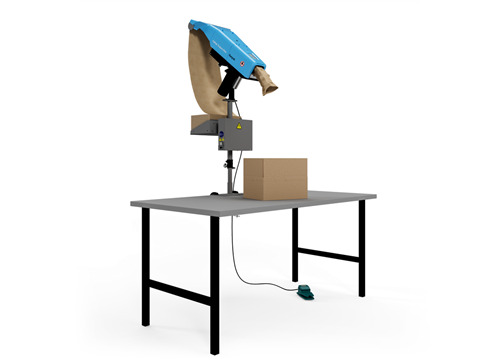
Antalis has added Ranpak’s FillPak Trident Mini void fill paper converter to its range of e-commerce equipment, with the space-saving machine filling delivery packaging with recyclable kraft paper.
The Trident Mini is intended to save warehouse space in busy packing stations with a compact footprint, sleek design, and configurable mounting options.
Its patented, triangular-shaped kraft paper pad is set to simplify the loading process for enhanced productivity, producing ‘effective’ void fill while cutting down on material use. At end-of-life, the paper can be recycled at kerbside.
Running at dispensing speeds of up to 1.4m/s, the machine offers five operating modes, including EDS, batch, and recipe. Through the HMI touchscreen, users can switch between and utilize these modes to produce customized packaging solutions.
The Trident Mini is also applicable in production processes for electrical retail and pharma products, in which multiple small products are packaged in a day.
Stuart Bates, head of Automation and Systems at Antalis, comments: “The new Trident Mini is a great addition to our range of void fill paper converters – which also includes the ever-popular Geami WrapPak manual converter – we have carefully curated for e-commerce businesses. Compact and mobile, these machines offer the flexibility e-commerce operations need to manage the ebb and flow of demand.”
The news comes after Ranpak brought its Geami Wrap ’n Go converter to the North American market last year. This solution turns kraft paper into protective, pack-in-store packaging for fragile items and aims to replace plastic solutions.
E-commerce giant Amazon has taken the approach of trialling automated packaging machines for on-demand, made-to-measure paper bags; these are set to reduce unnecessary volume and weight in product packaging, therefore lowering carbon emissions in the delivery process.
Since the announcement, the company has revealed that 100% of its delivery packaging in Europe— boxes, bags, and envelopes — is compatible with household recycling.
If you liked this article, you might also enjoy:
The Lidl approach to packaging sustainability
How did Brazil achieve its 100% aluminium can recycling rate – and can it be replicated in the EU?
Experts have their say on the EU’s Packaging and Packaging Waste Directive revisions
A deep dive into the most important packaging sustainability trends and solutions












No comments yet